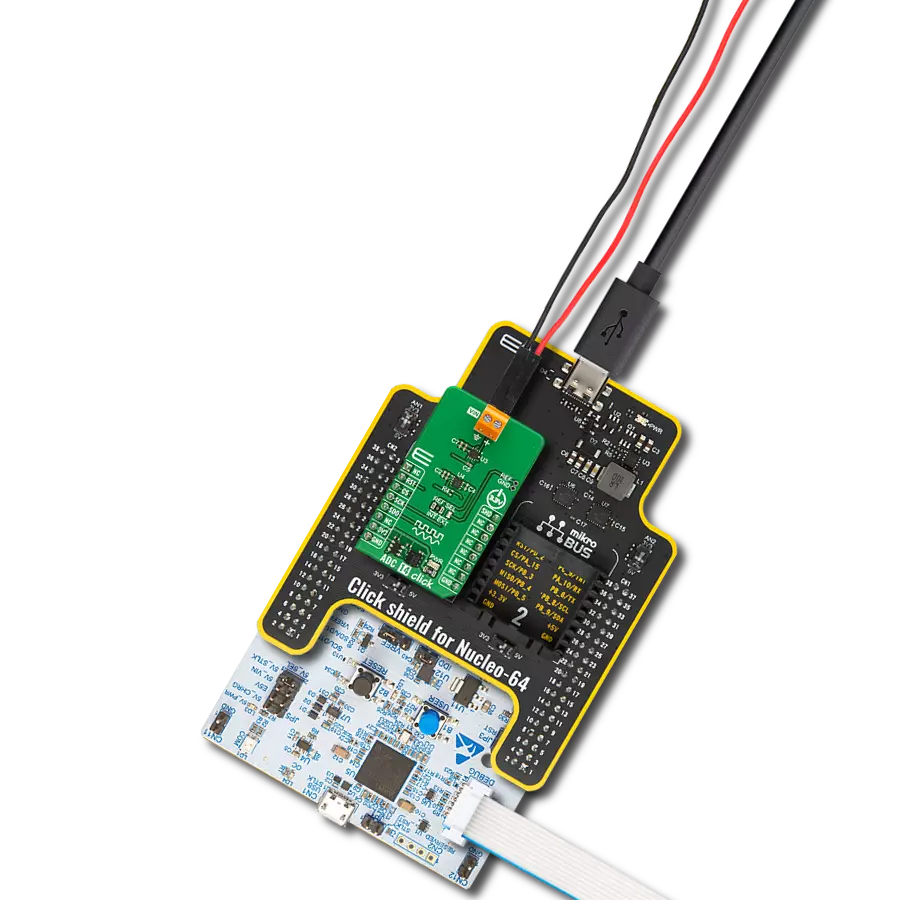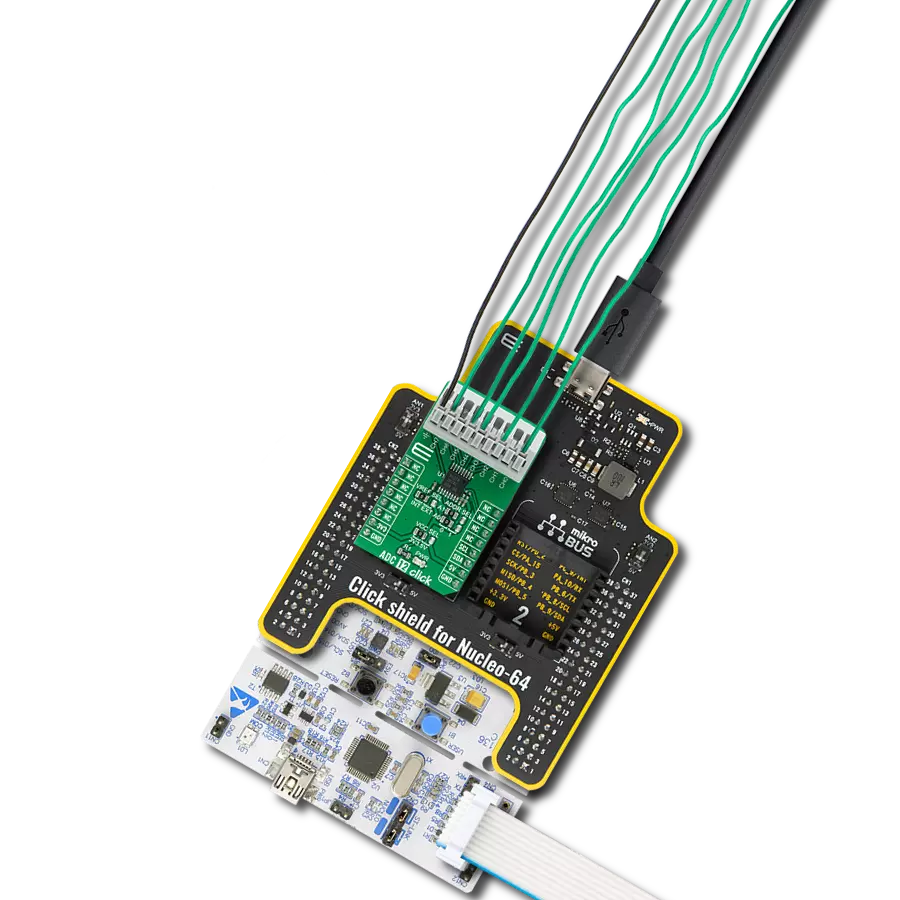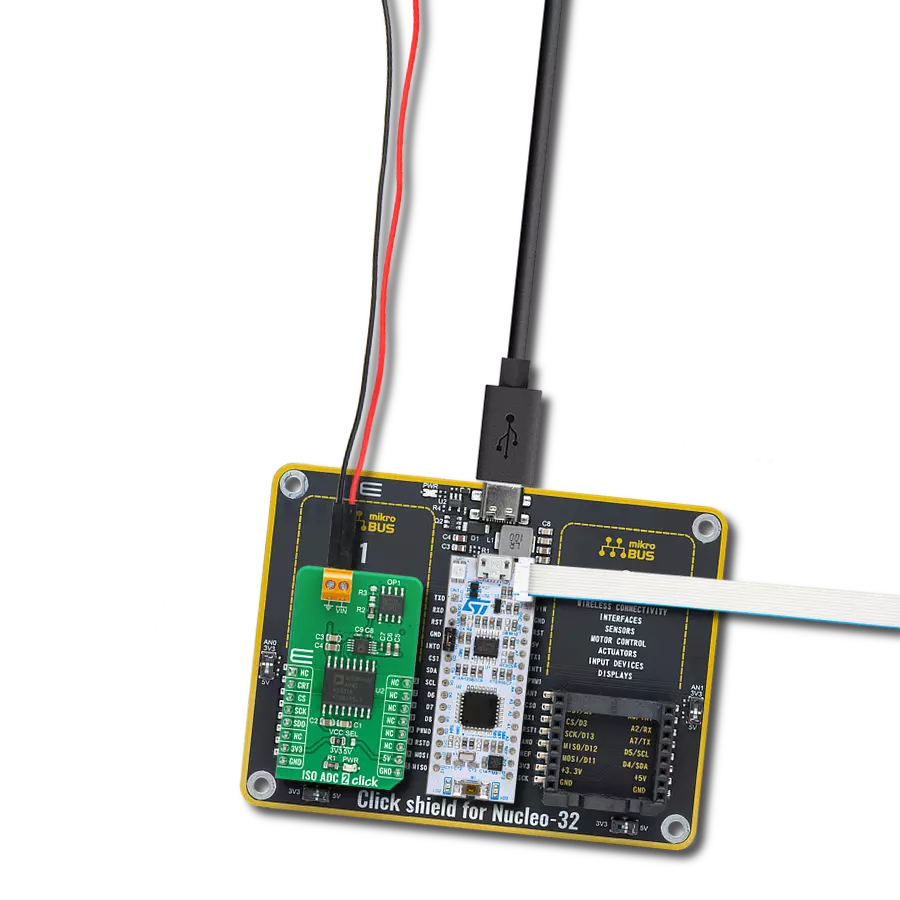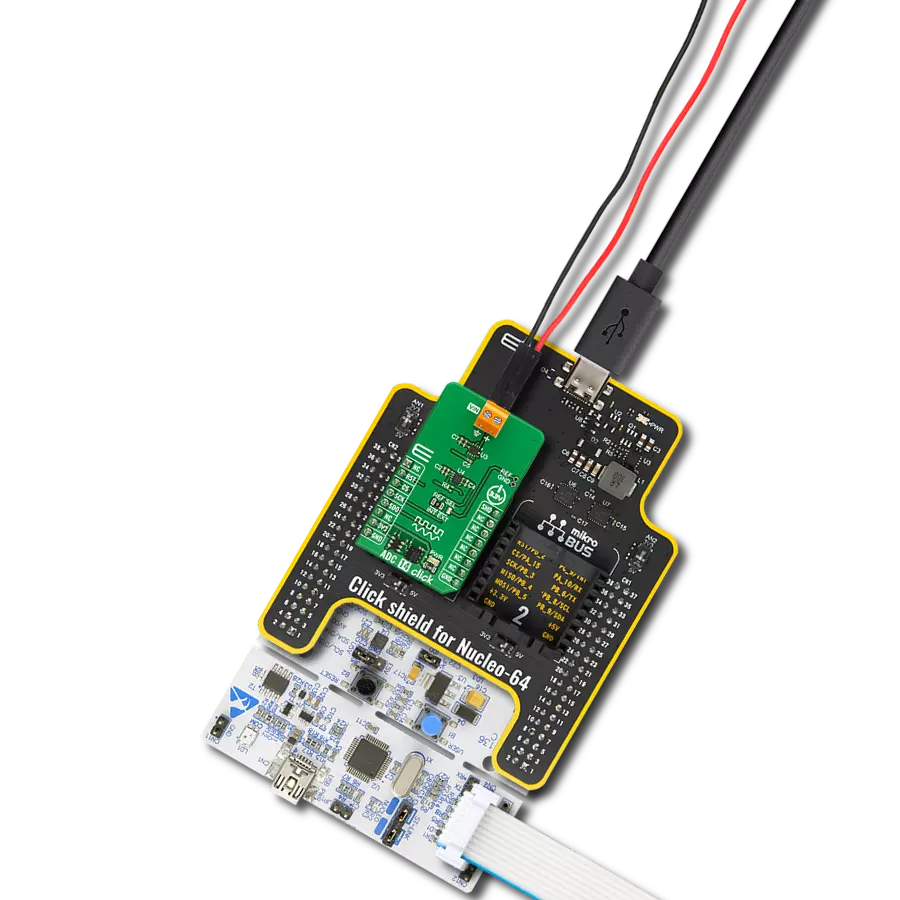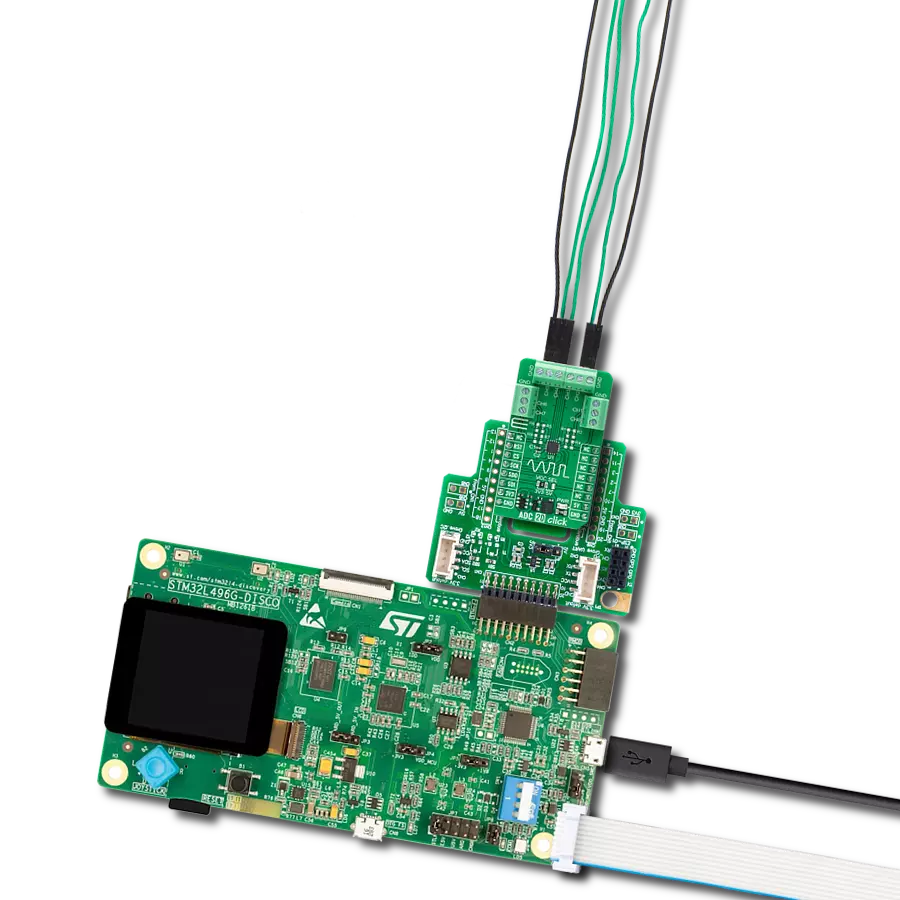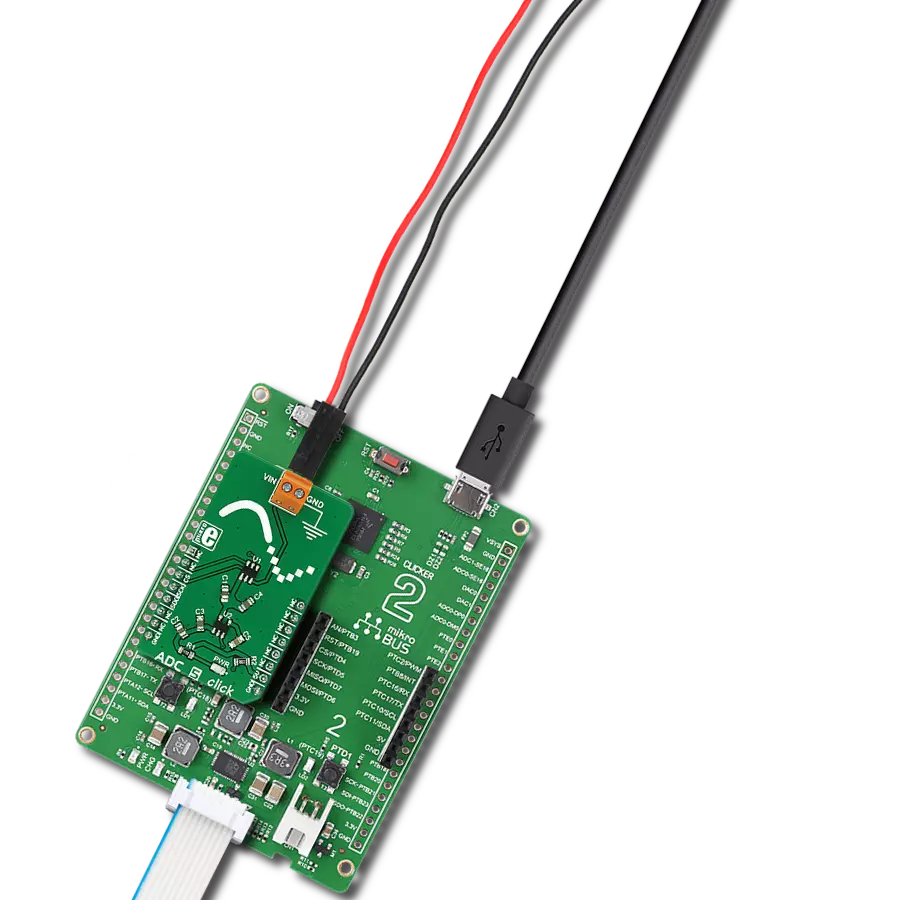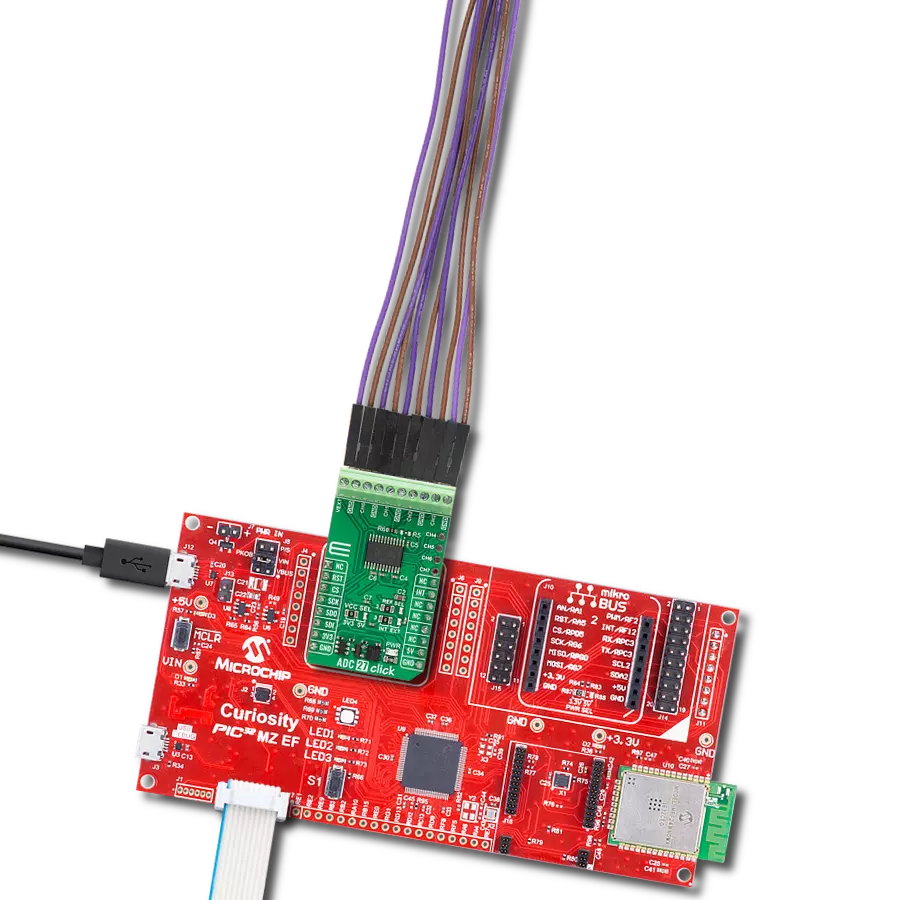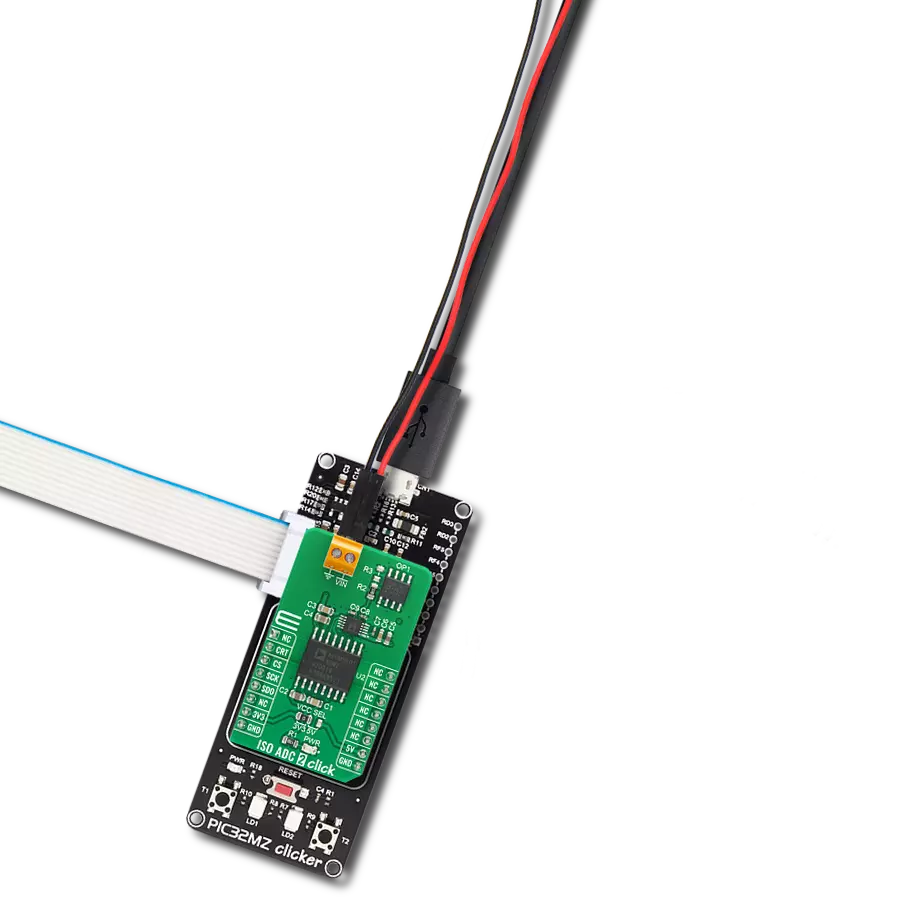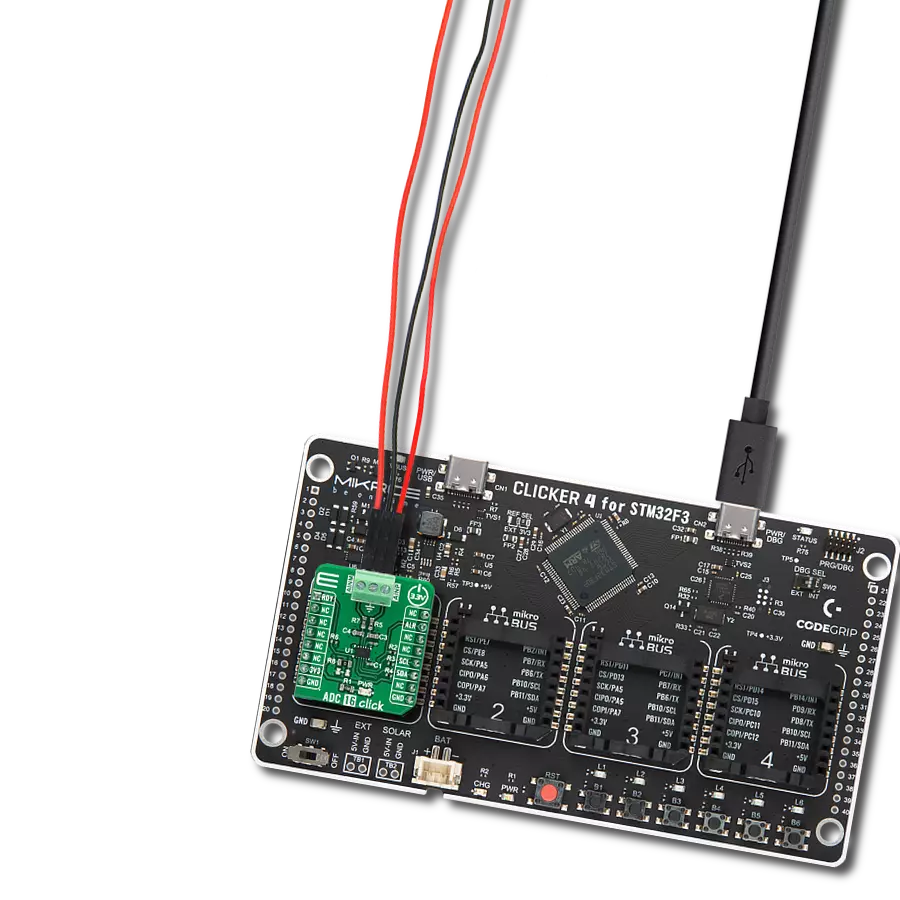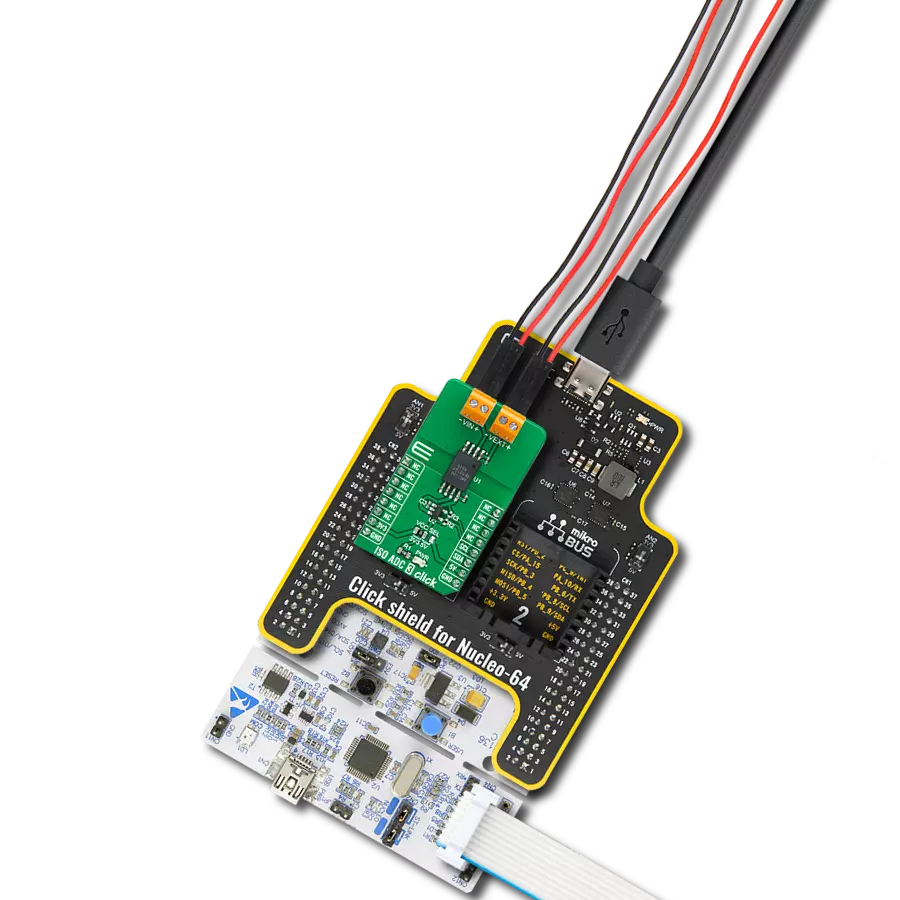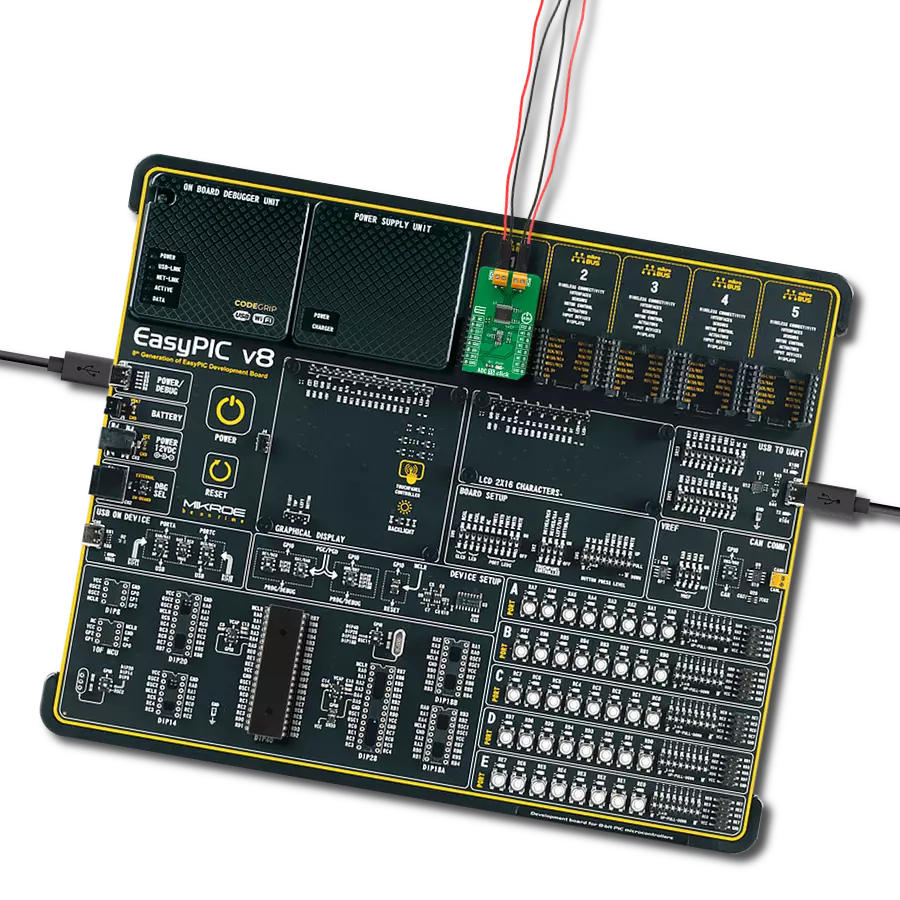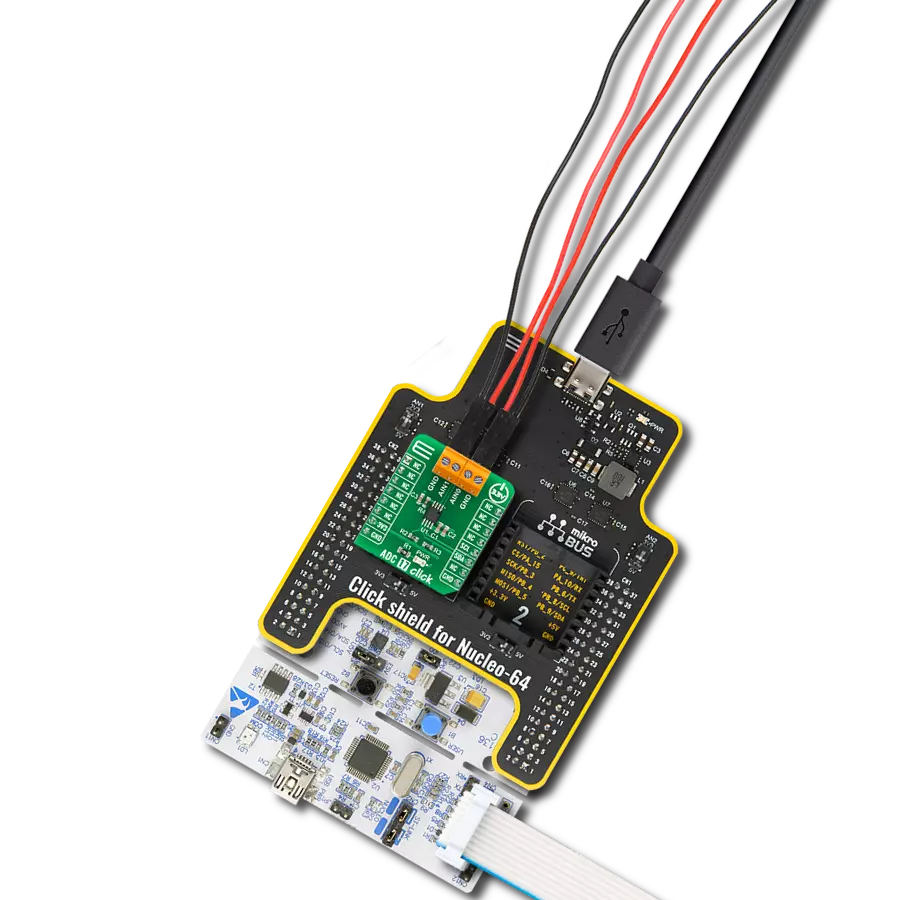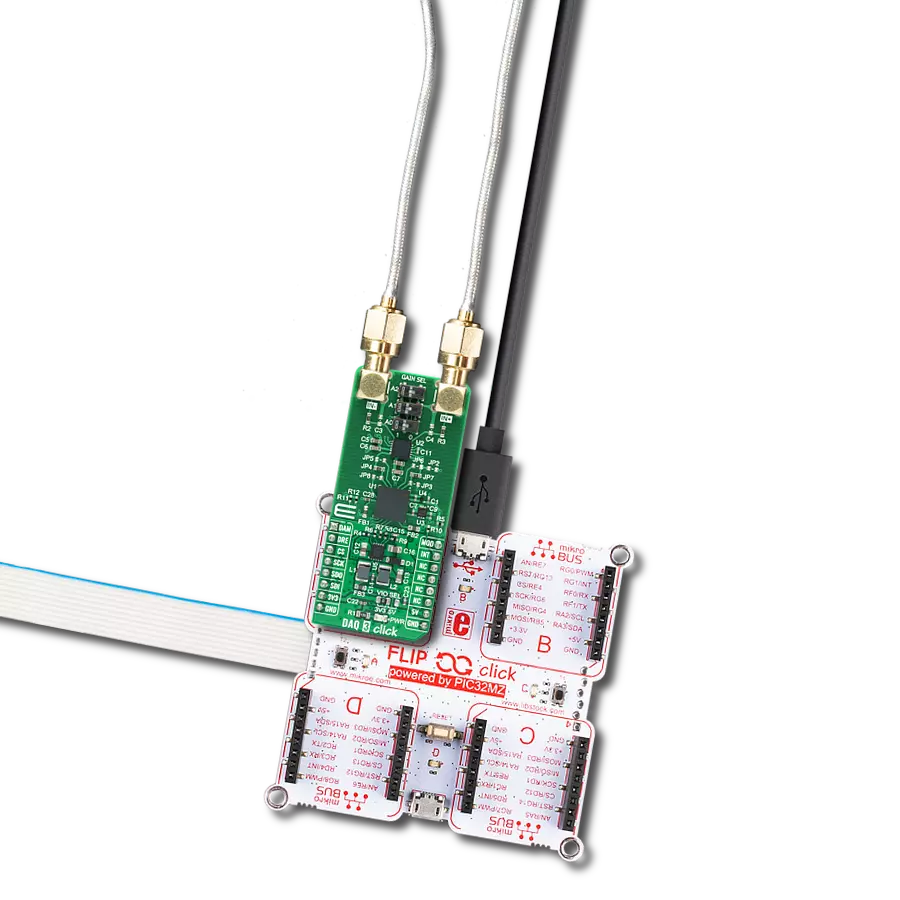Ready to take your designs to new heights? Discover how our ADC solution can elevate your design!
A
A
Hardware Overview
How does it work?
ADC 8 Click is based on the ADS1115, an ultra-small, low-power, high-precision, 16-bit A/D converter from Texas Instruments. It is a delta-sigma converter with an integrated high-precision voltage reference, which can be programmed in several different steps. The maximum data rate of this ADC is 860 SPS; however, it features an excellent signal-to-noise ratio (SNR). The ADS1115 has two differential or four single-ended inputs. The internal multiplexer is used to select the active input. The input pins are routed to two input terminals on the edge of the Click board™, allowing it to be easily interfaced with the analog signal source. Besides the power supply and I2C interface pins, the ADS1115 has an additional ALERT/RDY pin to signal conversion data available on the output register. This pin can also be set to output an overvoltage event. An internal comparator module can detect if the
input signal exceeds the voltage reference level and report the overvoltage event at the ALERT/RDY pin. This pin is routed to the mikroBUS™ INT pin. Both I2C pins, along with the ALERT/RDY pin, are pulled to a HIGH logic level by the pull-up resistors. The conversion output is available over the I2C interface in 16-bit two’s complement LSB/MSB format. A positive input signal can have values from 0x0001 to 0x7FFF, while the negative input signal can have values from 0x0000 to 0x8000. The slave I2C address of the device can be selected by moving the SMD jumper labeled as ADDR. It allows four different I2C addresses to be selected, and thus, up to four different ADC 8 clicks can be used on a single I2C bus. The signal to Noise ratio (SNR) depends on the reference voltage and output data rate. Delta-sigma ADCs are based on the oversampling principle: the input signal is sampled at a
higher frequency and filtered and decimated until the output value is obtained at the requested output data rate. The ratio between the high sampling frequency (modulator) and the output data rate is called oversampling ratio (OSR). Increasing the OSR, less noise appears at the output since more values are included in the averaging process. As mentioned, the ADS1115 IC cannot use an external voltage reference. However, it has a high-precision internal reference with low drift over temperature. It can be selected from several available values: ±0.256, ±0.512, ±1.024, ±2.048V, ±4.096, and ±6.144. Note, however, that the input signal should not be greater than VCC + 0.3V. In other words, it is not possible to use the 4.096V if the power supply source is 3.3V. ADC 8 click is equipped with the SMD jumper labeled as VCC SEL, which allows selection between 3.3V and 5V.
Features overview
Development board
Nucleo-64 with STM32F091RC MCU offers a cost-effective and adaptable platform for developers to explore new ideas and prototype their designs. This board harnesses the versatility of the STM32 microcontroller, enabling users to select the optimal balance of performance and power consumption for their projects. It accommodates the STM32 microcontroller in the LQFP64 package and includes essential components such as a user LED, which doubles as an ARDUINO® signal, alongside user and reset push-buttons, and a 32.768kHz crystal oscillator for precise timing operations. Designed with expansion and flexibility in mind, the Nucleo-64 board features an ARDUINO® Uno V3 expansion connector and ST morpho extension pin
headers, granting complete access to the STM32's I/Os for comprehensive project integration. Power supply options are adaptable, supporting ST-LINK USB VBUS or external power sources, ensuring adaptability in various development environments. The board also has an on-board ST-LINK debugger/programmer with USB re-enumeration capability, simplifying the programming and debugging process. Moreover, the board is designed to simplify advanced development with its external SMPS for efficient Vcore logic supply, support for USB Device full speed or USB SNK/UFP full speed, and built-in cryptographic features, enhancing both the power efficiency and security of projects. Additional connectivity is
provided through dedicated connectors for external SMPS experimentation, a USB connector for the ST-LINK, and a MIPI® debug connector, expanding the possibilities for hardware interfacing and experimentation. Developers will find extensive support through comprehensive free software libraries and examples, courtesy of the STM32Cube MCU Package. This, combined with compatibility with a wide array of Integrated Development Environments (IDEs), including IAR Embedded Workbench®, MDK-ARM, and STM32CubeIDE, ensures a smooth and efficient development experience, allowing users to fully leverage the capabilities of the Nucleo-64 board in their projects.
Microcontroller Overview
MCU Card / MCU

Architecture
ARM Cortex-M0
MCU Memory (KB)
256
Silicon Vendor
STMicroelectronics
Pin count
64
RAM (Bytes)
32768
You complete me!
Accessories
Click Shield for Nucleo-64 comes equipped with two proprietary mikroBUS™ sockets, allowing all the Click board™ devices to be interfaced with the STM32 Nucleo-64 board with no effort. This way, Mikroe allows its users to add any functionality from our ever-growing range of Click boards™, such as WiFi, GSM, GPS, Bluetooth, ZigBee, environmental sensors, LEDs, speech recognition, motor control, movement sensors, and many more. More than 1537 Click boards™, which can be stacked and integrated, are at your disposal. The STM32 Nucleo-64 boards are based on the microcontrollers in 64-pin packages, a 32-bit MCU with an ARM Cortex M4 processor operating at 84MHz, 512Kb Flash, and 96KB SRAM, divided into two regions where the top section represents the ST-Link/V2 debugger and programmer while the bottom section of the board is an actual development board. These boards are controlled and powered conveniently through a USB connection to program and efficiently debug the Nucleo-64 board out of the box, with an additional USB cable connected to the USB mini port on the board. Most of the STM32 microcontroller pins are brought to the IO pins on the left and right edge of the board, which are then connected to two existing mikroBUS™ sockets. This Click Shield also has several switches that perform functions such as selecting the logic levels of analog signals on mikroBUS™ sockets and selecting logic voltage levels of the mikroBUS™ sockets themselves. Besides, the user is offered the possibility of using any Click board™ with the help of existing bidirectional level-shifting voltage translators, regardless of whether the Click board™ operates at a 3.3V or 5V logic voltage level. Once you connect the STM32 Nucleo-64 board with our Click Shield for Nucleo-64, you can access hundreds of Click boards™, working with 3.3V or 5V logic voltage levels.
Used MCU Pins
mikroBUS™ mapper
Take a closer look
Click board™ Schematic

Step by step
Project assembly
Software Support
Library Description
This library contains API for ADC 8 Click driver.
Key functions:
adc8_get_diff_channel- Get diff channel voltageadc8_get_single_channel- Get single channel voltageadc8_get_interrupt_state- Get interrupt pin state
Open Source
Code example
The complete application code and a ready-to-use project are available through the NECTO Studio Package Manager for direct installation in the NECTO Studio. The application code can also be found on the MIKROE GitHub account.
/*!
* \file
* \brief Adc8 Click example
*
* # Description
* The demo app shows voltage measurement across all singles and different channels.
*
* The demo application is composed of two sections :
*
* ## Application Init
* Configuring Clicks and log objects.
* Settings the Click in the default configuration.
*
* ## Application Task
* Reads voltage from each channel one by one and the voltage difference
* between specified channels.
*
* *note:*
* On the input channel AIN0, AIN1, AIN2 and AIN3 sets maximum voltage
* GND - 0.3V < VIN > VDD + 0.3V
*
* \author Katarina Perendic
*
*/
// ------------------------------------------------------------------- INCLUDES
#include "board.h"
#include "log.h"
#include "adc8.h"
// ------------------------------------------------------------------ VARIABLES
static adc8_t adc8;
static log_t logger;
// ------------------------------------------------------ APPLICATION FUNCTIONS
void application_init ( void )
{
log_cfg_t log_cfg;
adc8_cfg_t cfg;
/**
* Logger initialization.
* Default baud rate: 115200
* Default log level: LOG_LEVEL_DEBUG
* @note If USB_UART_RX and USB_UART_TX
* are defined as HAL_PIN_NC, you will
* need to define them manually for log to work.
* See @b LOG_MAP_USB_UART macro definition for detailed explanation.
*/
LOG_MAP_USB_UART( log_cfg );
log_init( &logger, &log_cfg );
log_info( &logger, "---- Application Init ----" );
// Click initialization.
adc8_cfg_setup( &cfg );
ADC8_MAP_MIKROBUS( cfg, MIKROBUS_1 );
adc8_init( &adc8, &cfg );
adc8_default_cfg( &adc8 );
log_info( &logger, "---- ADC start ----" );
}
void application_task ( void )
{
adc8_single_volt_t single_volt;
adc8_diff_volt_t diff_volt;
log_printf( &logger, "\r\n-----------------------------------" );
// Single channel
adc8_get_single_channel( &adc8, &single_volt );
log_printf( &logger, "\r\n>>> SINGLE CHANNEL <<<<\r\n" );
log_printf( &logger, "- CH 0: %.2f\r\n", single_volt.ch_0 );
log_printf( &logger, "- CH 1: %.2f\r\n", single_volt.ch_1 );
log_printf( &logger, "- CH 2: %.2f\r\n", single_volt.ch_2 );
log_printf( &logger, "- CH 3: %.2f\r\n", single_volt.ch_3 );
// Diff channel
adc8_get_diff_channel( &adc8, &diff_volt );
log_printf( &logger, "\r\n>>> DIFF CHANNEL <<<<\r\n" );
log_printf( &logger, "- CH(0-1): %.2f\r\n", diff_volt.ch_0_1 );
log_printf( &logger, "- CH(0-3): %.2f\r\n", diff_volt.ch_0_3 );
log_printf( &logger, "- CH(1-3): %.2f\r\n", diff_volt.ch_1_3 );
log_printf( &logger, "- CH(2-3): %.2f\r\n", diff_volt.ch_2_3 );
Delay_ms ( 1000 );
}
int main ( void )
{
/* Do not remove this line or clock might not be set correctly. */
#ifdef PREINIT_SUPPORTED
preinit();
#endif
application_init( );
for ( ; ; )
{
application_task( );
}
return 0;
}
// ------------------------------------------------------------------------ END
Additional Support
Resources
Category:ADC



















